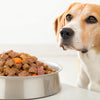Can a Puppy Eat Wet Dog Food? Exploring the Best Options for Our Furry Friends
- Houndsy
Table of Contents
- Introduction
- Understanding Puppy Nutrition
- Can Puppies Eat Wet Dog Food?
- Transitioning to Wet Dog Food
- Considerations When Feeding Wet Dog Food
- Conclusion
Introduction
Welcoming a new puppy into our lives brings immense joy and excitement, but it also poses several questions about proper care—especially regarding nutrition. Did you know that the nutritional choices we make for our puppies during their early days can significantly impact their growth and health? For many of us, a common question arises: can a puppy eat wet dog food? The simple answer is yes, but let’s dive deeper into why wet food is not only permissible but often recommended for our precious pups.
In this blog post, we aim to guide you through understanding the essentials of incorporating wet dog food into your puppy’s diet. You’ll learn about the benefits of wet dog food, how to introduce it into your pup’s meals, and best practices for feeding. By the end of this article, we hope to empower you with knowledge about your puppy’s nutritional needs and the ways we can provide the best diet during their formative years.
We’ll cover the nutritional differences between wet and dry food, appropriate feeding practices for puppies, and everything else you need to confidently make the best choices for your growing pup. Let’s explore the world of wet dog food and how it can enhance our furry friends' experiences!
Understanding Puppy Nutrition
The Importance of Proper Nutrition
Just like human children, puppies require a balanced diet tailored to their specific developmental needs. A proper diet not only fuels their daily activities but also plays a vital role in their long-term health. Puppies undergo rapid growth in their first year, potentially reaching their adult size between 9 to 24 months, depending on their breed. This period of intense growth necessitates more protein, fat, vitamins, and minerals than adult dogs need.
Puppy Nutritional Requirements
Key nutritional elements for puppies include:
- Protein: Essential for muscle development and overall growth.
- Fats: Provide energy and support the absorption of certain vitamins.
- Vitamins and Minerals: Crucial for metabolic processes, bone development, and immune function.
- Water: Adequate hydration supports digestion and overall health.
Given these needs, it’s clear that our choices in food must ensure they reach nutritional adequacy. Whether wet or dry, the food should meet standards set by the Association of American Feed Control Officials (AAFCO) for puppies to ensure it meets the necessary nutrient levels.
Can Puppies Eat Wet Dog Food?
The Right Timing to Introduce Wet Food
The weaning process, which typically begins between weeks 3 to 4, marks the time when puppies transition from their mother's milk to solid foods. During this transition, wet dog food often plays a pivotal role. At around four weeks, inserting wet dog food mixed with water into their diet can help ease this shift. This introduces puppies to the texture and taste of solid food in a gentle manner.
Once puppies reach around eight weeks, they are generally fully weaned and can steadily consume wet dog food without any additional forms of milk. The soft texture of wet food is easier on their delicate, still-developing teeth, making this stage a fantastic time to introduce wet food into their routine.
Benefits of Wet Dog Food for Puppies
-
Ease of Chewing: The texture of wet dog food is gentle on puppies' tender teeth, making it ideal for those just transitioning from nursing.
-
Higher Moisture Content: Wet food contains significant moisture, aiding in hydration. This is particularly beneficial during the hot months or for pups that don’t drink enough water.
-
Enhanced Palatability: The rich aroma and flavor of wet food often appeal more to puppies, increasing their willingness to eat and ensuring they get the nutrients they need.
-
Convenient Transition: Wet food can seamlessly mix with dry kibble if you decide to create a varied feeding regimen as your puppy matures.
Choosing the Right Wet Dog Food
As responsible pet owners, it’s essential to opt for high-quality wet dog food that provides the necessary nutrients our puppies need. When evaluating options, consider the following:
- Complete and Balanced: Ensure that the food is labeled “complete and balanced” according to AAFCO standards.
- High-Quality Ingredients: Choose foods with recognizable ingredients, such as real meats and vegetables, avoiding fillers like corn and artificial additives.
- Age-Appropriate Formulas: Puppies have different nutritional requirements compared to adult dogs, so it’s important to select food specifically formulated for puppies.
Transitioning to Wet Dog Food
Introduction to Wet Food: A Step-by-Step Guide
When introducing wet dog food to your puppy's diet, it’s crucial to do so gradually to prevent digestive upset. Here’s a practical approach:
-
Start with Gradual Mixing: Begin by mixing a small portion of wet food with your puppy's existing food. A common ratio is 75% dry food to 25% wet food, gradually adjusting the ratio over several days.
-
Monitor Reactions: Keep an eye on your puppy during this transition. Watch for signs of distress or allergies and consult a veterinarian if needed.
-
Adjust Texture as Needed: If your puppy is unsure how to handle the texture, consider blending the wet food with a bit of water to create a smoother consistency.
-
Encourage Eating: Offer meals at regular intervals, and don’t hesitate to make mealtime a fun experience with praise and interaction.
Feeding Practices
How Much Wet Food to Feed Your Puppy?
Puppies generally require several meals a day—typically four meals when they are very young. It’s vital to refer to the packaging of the specific wet food you choose, as recommendations can vary based on your puppy’s age, weight, and activity level. Consulting your veterinarian can provide personalized recommendations tailored to your puppy's development.
Signs of Healthy Eating Habits:
- Bright Eyes: A puppy's energy and enthusiasm should be evident.
- Healthy Weight: Ensure your puppy is gaining weight steadily and within the expected range for their breed.
- Regular Energy Levels: Playfulness and an eagerness to explore indicate proper nutrition.
Combining Wet and Dry Food
As our puppies grow, many pet owners choose to mix wet and dry food to provide a balanced diet. Doing so can have distinct advantages:
-
Improved Palatability: Mixing wet and dry food can make meals more enticing for picky eaters.
-
Increased Water Intake: Wet food helps maintain hydration levels, while dry kibble aids in dental health.
-
Cost-Effective: Using a combination can be a more economical option while still maintaining quality nutrition.
-
Flexible Feeding Options: Combining allows variations in feeding based on your puppy’s mood, appetite, or changing health needs.
Considerations When Feeding Wet Dog Food
Dental Health Concerns
While wet food offers many benefits for puppies, it’s important to acknowledge potential downsides. Wet dog food can sometimes contribute to dental issues because it doesn’t provide the natural scrubbing effect that dry kibble can have on teeth. However, by:
- Providing Dental Chews: Incorporate dental-friendly chews into your puppy's routine.
- Regular Vet Check-Ups: Schedule dental check-ups to address any concerns early.
Possible Challenges with Diet Changes
Switching our puppies to wet food requires careful monitoring. Some may experience difficulty adjusting to new textures or flavors, resulting in digestive upsets. To mitigate this, always introduce food gradually and be patient as your puppy acclimates.
Frequently Asked Questions
Can all puppies eat wet dog food?
Yes, wet food can be introduced to all puppies, especially those transitioning from nursing. It’s important to select high-quality options that provide balanced nutrition suitable for growing dogs.
How much wet food should I feed my puppy daily?
Feeding guidelines typically recommend puppies eat between four meals a day, and the specific quantity will depend on their weight and age. Always consult the packaging and consider veterinary advice tailored to your puppy's needs.
Is wet food more expensive than dry food?
Wet food can be more expensive than dry kibble on a per-meal basis. However, the enhanced palatability and nutrition can make it worth the investment, especially during those critical growth phases.
Can wet food be given all the time?
While wet food can be part of your puppy’s daily diet, moderation is key. It can be combined with dry food for a balanced approach to ensure dental health and nutritional diversity.
Does wet food promote weight gain in puppies?
When selected properly, high-quality wet food should not promote unhealthy weight gain. Instead, it can help maintain optimal body weight while ensuring adequate hydration. Always monitor your puppy's weight and consult a vet for adjustments as needed.
Conclusion
As we’ve explored, wet dog food can play an essential role in the nutrition of our beloved puppies. From providing a suitable texture for their developing teeth to ensuring adequate hydration, introducing wet food can enhance their dining experience and help them grow into healthy, strong adults. By choosing high-quality options and introducing food gradually, we can lay the groundwork for a lifetime of healthy eating practices for our furry companions.
Ultimately, each puppy's dietary needs may vary, and it's crucial to remain attentive to their unique reactions and preferences. If you’re considering adding wet food to your puppy's diet or talking further about feeding routines, we encourage you to explore offerings such as the Houndsy Kibble Dispenser, designed to make mealtime a delightful and manageable experience.
Let’s prioritize our puppies’ nutrition, ensuring they have the energetic and joyful lives they deserve!












